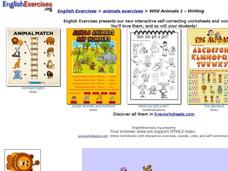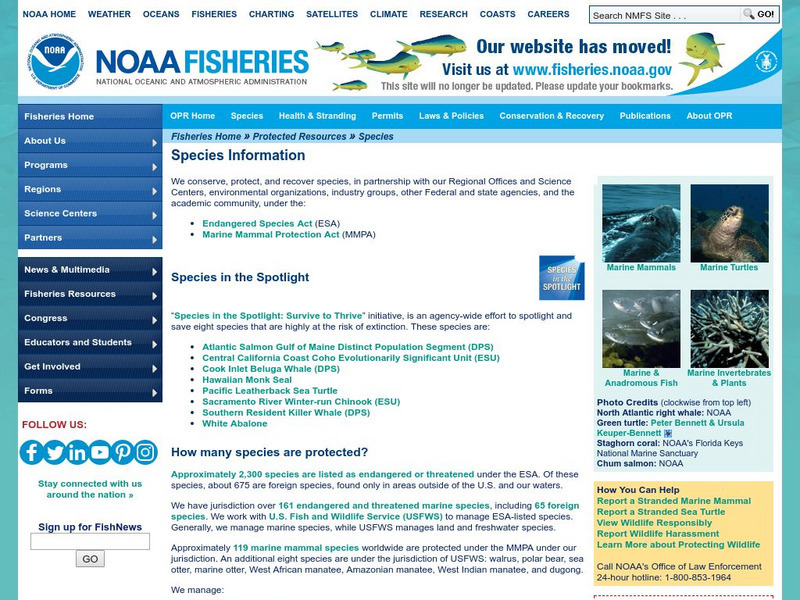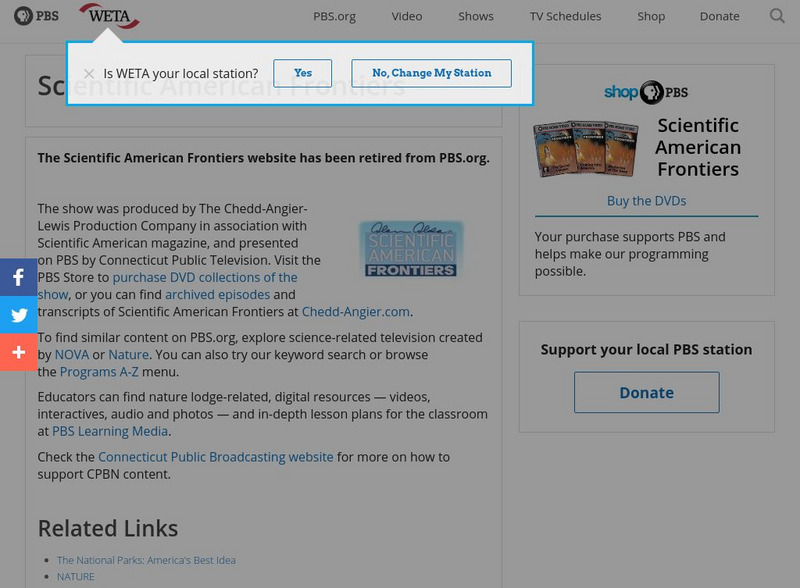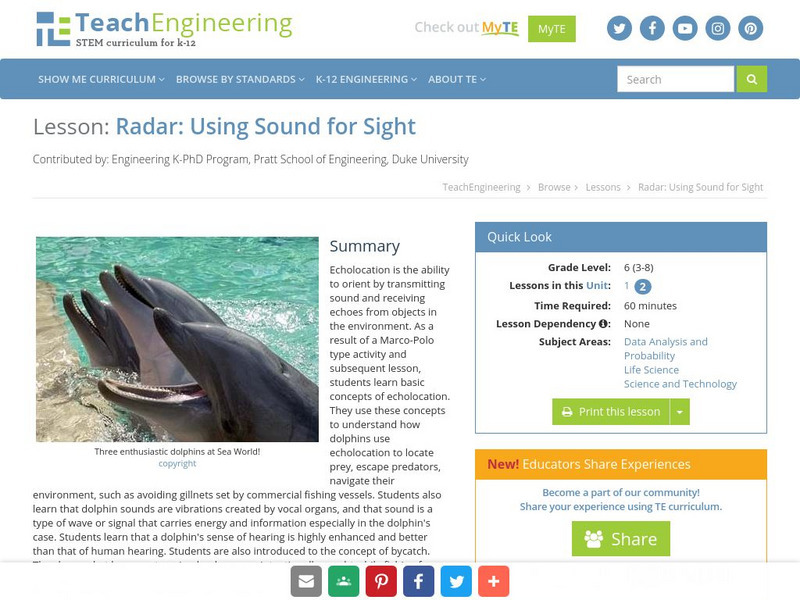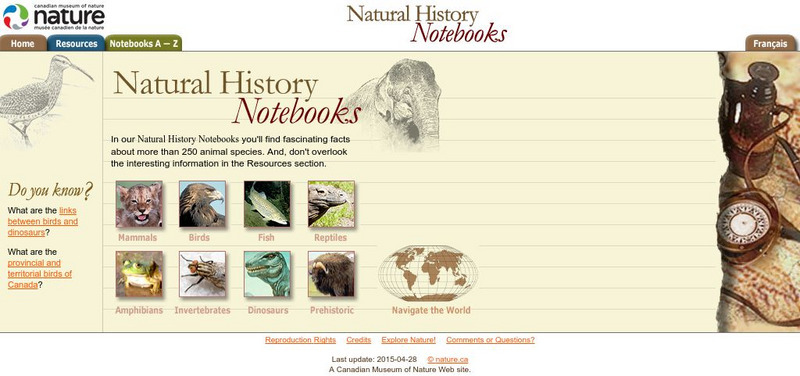Curated OER
Explorit's Bone Quiz
In this bones worksheet, students complete a ten question short answer quiz about human and animal bones. Students answer each question and self check. It appears that this is an online interactive worksheet.
Curated OER
States and Territories: Vocabulary Follow-Up
In this states and territories worksheet, students fill in blanks in sentences, using given vocabulary words at the top of the page. A reference web site is given for additional activities.
Curated OER
ESL Vocabulary-Animals
In this ESL vocabulary worksheet, students study a chart of pictures and animal names, then unscramble names, watch a video and list animals seen, fill in missing letters, complete an animal crossword and classify given animals.
NOAA
Noaa: National Marine Fisheries Headquarters
This home page provides links to fisheries organizations, research and regulations.
San Diego Zoo Global
San Diego Zoo: Fishing Cat
The San Diego Zoo provides extensive information on fishing cats including details about their habitat, size, diet, family life, conservation status, and fun facts.
NOAA
Noaa: Puffy the Puffer's Book of Fun Fish Facts
Step inside "Puffy The Puffer's Book Of Fun Fish Facts," and learn all about marine mammals. There are quizzes, games and lots of fun information.
NOAA
Noaa: Fisheries: Cetaceans: Whales, Dolphins, and Porpoises
Learn more about the marine mammal group of cetaceans. Take a look at their status on the Endangered list and find out what situations put them on that list.
Alabama Learning Exchange
Alex: My Book About Animals
This instructional activity will allow students an opportunity to create a book about the different characteristics of mammals, birds, fish, reptiles, and insects. This instructional activity can be used as a wrap-up project for a unit...
Other
San Francisco Zoo: Fishing Cat
Detailed information and fascinating facts about the blue-winged teal include diet, habitat, physical features, behavior, and conservation status.
Other
Science4 Us: Animals
In online and offline activities, students broaden their understanding of animals by learning to identify and classify animals into six categories: mammals, birds, fish, amphibians, reptiles, and invertebrates.
ClassFlow
Class Flow: All About Whales
[Free Registration/Login Required] The objective of this lesson about whales is to learn about the differences between mammals and fish using the Venn diagram. The lesson also covers charting animal sizes and ends with a 10-question...
PBS
Pbs Teachers: Scientific American: The New Zoos: Doctor Fish
Investigate the evolution of the heart and circulatory system in mammals by studying the anatomy of hearts in other animals. Create models of the hearts of fish, amphibians and mammals.
Other
Florida Fish and Wildlife Conservation Commission: Perdido Key Beach Mouse [Pdf]
Learn about the endangered beach mouse form Alabama called the Perdido Key Beach Mouse. Find out some important biological information about this species.
US Fish and Wildlife Service
U.s. Fish & Wildlife Service: Alabama Beach Mouse
Read about the endangered Alabama Beach Mouse, and find out what can be done to restore its population numbers.
Other
Florida Department of Environmental Protection: Life in a Spring
Learn all about the diverse species that live in the Florida Springs. Separate sections for fish, reptiles and amphibians, birds and mammals, insects and invertebrates, and plants.
Smithsonian Institution
Smithsonian National Zoo
Here is the National Zoological Park right at our fingertips. Students will find many things to explore at this colorful and engaging site. Any study of animals will have a successful start here. Chances are students can catch their...
NSTATE
Hawaii State Symbols
Learn all about Hawaii's state symbols including the state bird, flower, fish, dance, flag, and more. Click on the symbol name to see a picture and learn more information.
University of Florida
Florida Museum of Natural History: Animals 1: Fur, Fins, Feathers, and More
This teacher's guide focuses on familiar animals such as mammals, birds, reptiles, amphibians, and fish.
TeachEngineering
Teach Engineering: Sound for Sight
Echolocation is the ability to orient by transmitting sound and receiving echoes from objects in the environment. As a result of a Marco-Polo type activity and subsequent lesson, students learn basic concepts of echolocation. They use...
Biology Pages
Kimball's Biology Pages: Vertebrate Kidneys
Everything you've ever wanted to know about vertebrate kidneys. Modules include Freshwater Vertebrates, Amphibians, Lizards and Snakes, Birds, Mammals, Marine Fishes. Resources can be used as classroom notes or supplemental materials.
Canadian Museum of Nature
Canadian Museum of Nature: Natural History Notebooks
This site from the Canadian Museum of Nature, a natural history museum, provides short information blurbs and fun facts on over 240 different common animals categorized by type (mammals, fish, reptiles, invertebrates, amphibians,...
National Wildlife Federation
National Wildlife Fed.: Restoring the Gulf
The Wildlife Federation has committed itself to saving the wildlife and habitat of the Gulf of Mexico oil spill area. They report on how many animals have been reported dead, how many are oiled but alive and how many cleaned and...
Smithsonian Institution
National Museum of Natural History: American Mammals: Harbor Porpoise
Large numbers of harbor porpoises are caught in fishing nets, because the porpoises feed on schooling fish such as herring and mackerel, in relatively shallow coastal waters. They are also affected by increasing pollution in coastal...
Smithsonian Institution
National Museum of Natural History: American Mammals: Pacific White Sided Dolphin
Before the United Nations established a moratorium on the use of high seas drift nets in 1993, Pacific white-sided dolphins were frequently caught in the nets of Japanese and Korean squid fisheries. Today the species is better protected,...




